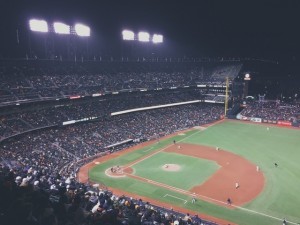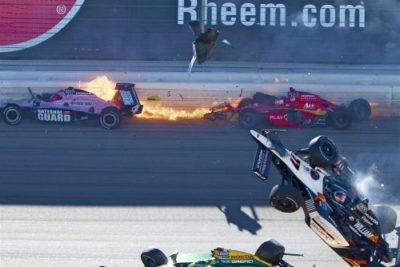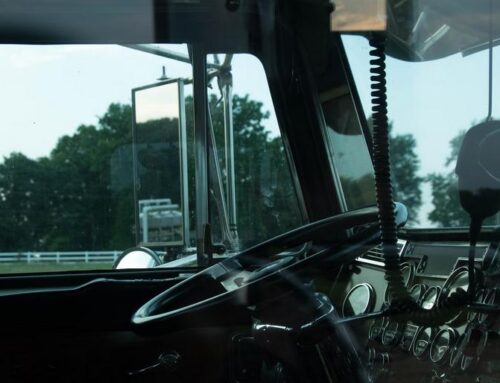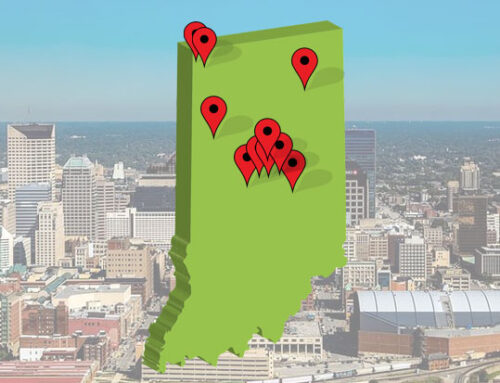The bright sun. The sounds of roaring engines. The aroma of deep-fried pork tenderloins. The sight of hundreds of balloons released into the air. To residents of Indianapolis, May means one thing: it’s time again for the Indianapolis 500. For a hundred years, spectators from across the world have made the annual pilgrimage to the Indianapolis Motor Speedway. During that time, they’ve weathered the dangers inherent in attending the Greatest Spectacle in Racing: heat stroke, dehydration, hearing damage and the occasional fight with fellow inebriated spectators.
There is, however, another far more severe danger lurking at every running of “The 500” – the risk of spectators being hit by flying debris resulting from a car crash at 200+ MPH. Most people do not consider this danger, but it’s not entirely rare. Just this year, NASCAR settled a lawsuit stemming from the 2013 Daytona 500 in which a spectator suffered a traumatic brain injury after being struck in the head by flying debris – on the last lap no less. That case, and the excitement brought by the month of May, beg the question: if you are struck by flying debris at the Indy 500, can you make a personal injury claim? The short answer: yes, the long answer: yes, but it will be a tough fight. As always you’ll need to prove duty, breach, proximate cause, and damages. Obviously if you’re hit with flying debris the latter two will be obvious, but what about the duty a track owes to protect you and how can you tell if they breached that duty?
Does Indianapolis Motor Speedway Owe Spectators A Duty To Keep Them From Being Hit By Debris?
The owners and operators of sporting venues across Indiana are required to provide their patrons a certain level of protection. If they fail to provide that protection, they may be liable for injuries sustained by patrons. The specifics of the level of protection required depends on the venue and the event. Broadly speaking if the owners and/or operators know—or should know—that some aspect of their venue poses an unreasonable risk to their patrons, and patrons may not be aware of and therefore will not protect themselves from it, the owners and/or operators must exercise reasonable care in protecting their spectators.
If I Get Hit By Debris Has IMS Breached Its Duty To Protect Me?
Historically, the most common type of venue in which this question has come up has been baseball fields. The typical lawsuit involves a spectator being plunked on the head with a foul ball, errant throw, or thrown bat. In Indiana, the owners and operators of these fields have typically been in the clear so  long as they provide adequate fencing or netting behind home plate—where most foul balls land—and provide sufficient warning to spectators sitting elsewhere because of what is called Assumption of Risk. In short, you assume the risk of being hit by a foul ball when you go to a baseball game, so you can’t hold the team liable if it happens.
long as they provide adequate fencing or netting behind home plate—where most foul balls land—and provide sufficient warning to spectators sitting elsewhere because of what is called Assumption of Risk. In short, you assume the risk of being hit by a foul ball when you go to a baseball game, so you can’t hold the team liable if it happens.
If the same standard was applied to IMS, then the likelihood of a successful lawsuit is very low, but the Indianapolis 500 is not a baseball game, and the Indianapolis Motor Speedway is not a baseball field. There is a valid argument, however, that the same logic would not apply to race tracks. After all, baseballs are sent flying into the stands all the time—in 2016, there were an average of nearly 50 foul balls and homeruns combined every game. Flying debris at a race track is far less common. That also means the courts have had far less opportunity to weigh in on the matter. No court in Indiana has ever ruled on this, so any answer will need to be provided by other courts.
Flying Debris Lawsuits In Other States
Lawsuits pertaining to flying debris in other states have shown courts are willing to treat race tracks and baseball fields differently. Going back half a century courts in New York, California and Arkansas have all required a higher level of protection for spectators at race tracks than at baseball fields. As early as 1964 at least one court in California was willing to believe that flying debris striking a spectator creates a presumption of negligence (see Khanoyan v. All American Sports Enterprises, Inc.) or a breached duty.
After all, if a spectator is struck by flying debris even if there is a protective fence, clearly the fence was not tall or strong enough. While not going as far as to hold that it creates the presumption of negligence, Indiana courts have applied the “fence was too short” argument by stating that when one undertakes to protect another the protector incurs a legal duty to do so reasonably, even in baseball cases. (South Shore Baseball, LLC v. DeJesus, 11 N.E.3d 903, 910 (Ind. 2014.) If Indiana courts decide to treat the Indianapolis Motor Speedway the same way as baseball fields, an injured race fan will always be able to fall back on the argument that the fence was not built well enough.
At the end of the day expecting race track owners and operators to provide far more protection than is typically provided at baseball games makes sense legally. Flying debris resulting from a collision on the track is a risk in any automobile race, and so the owners and operators of should absolutely be aware of the danger posed to spectators. Since flying debris is an uncommon occurrence, though, most spectators are unlikely to appreciate the danger or protect themselves from it—even if warned. Simply put, race track owners and operators cannot expect fans to be as conscious of flying debris as they would be of foul balls at a baseball game.
Moreover, if a foul ball is hit toward a fan, the only thing they need to protect themselves is a baseball glove or a soon to be throbbing set of ungloved hands. If an Indy Car’s nose cone or wheel comes flying toward a spectator, there is next to nothing a spectator can do to avoid being injured. Legally it should be the responsibility of the race track to provide as much protection as possible. Whether the fencing surrounding the Indianapolis Motor Speedway is legally sufficient protection is a question for the courts, and the answer will likely depend on how different the courts believe the IMS and Victory Field are.
So, go to the race. Have fun. Eat junk food. Take in the sights and sounds of an Indianapolis tradition. But keep your eyes open for flying debris. And, if you are injured, make sure you take steps immediately to protect your legal rights. Start by calling an experienced personal injury lawyer.





